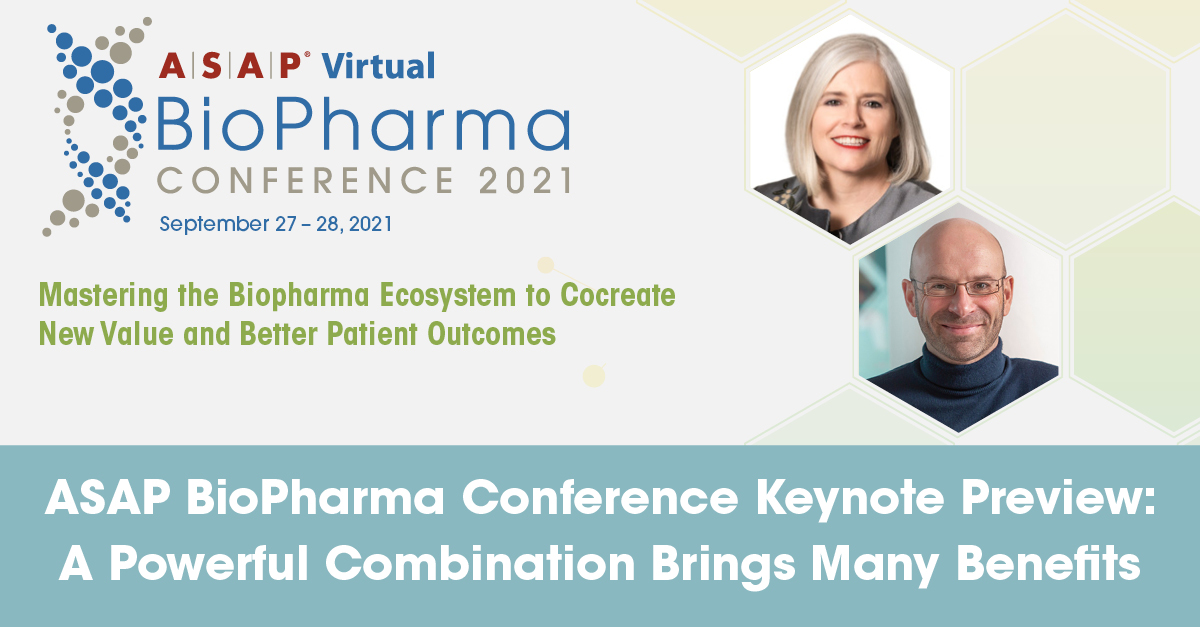ASAP BioPharma Conference Keynote Preview: A Powerful Combination Brings Many Benefits
How do you create a great collaboration?
Old alliance hands will tell you: it has to be built on trust, transparency, clear communication, and a compelling value proposition for both parties. And in biopharma, the results should benefit the patient as well.
It’s sage alliance wisdom—and represents just a fraction of the insights to be gleaned beginning Monday, September 27, in the keynote address opening the 2021ASAP BioPharma Conference. And it’s a two-for-one: Helen Torley, CEO and board member of Halozyme Therapeutics, and Tim Van Hauwermeiren, cofounder and CEO of argenx, will speak on “The Power of Collaboration in Bringing Greater Value to Patients.”
In a great collaboration, each side brings something to the table. In the case of Halozyme, it’s the company’s Enhanze® drug delivery technology, which facilitates subcutaneous injection of certain drugs, thus saving time and in some cases avoiding lengthy hospital or clinic visits. Halozyme has entered into 11 collaborations so far to marry its technology with its partners’ drug candidates—a powerful combination for pharma companies looking for alternative means of drug delivery.
A World of Difference
One such company is argenx, which brings a very promising asset in the form of efgartigimod (ARGX-113), currently being investigated for potential treatment of six autoimmune diseases including myasthenia gravis. CEO Tim Van Hauwermeiren said the combination of argenx’s asset with Halozyme’s technology is definitely a win-win.
“The beauty of Halozyme’s technology [is] you can [take] a one-hour infusion, for which you need to drive a few hours in many cases, you need to register, you need to sometimes be premedicated, then you sit in the chair for an hour, then they need to monitor you for another 30 minutes, then you drive back home again—if you can replace that with a 30-second self-administered shot under the skin, that is a world of difference,” he said.
That’s especially true in a pandemic, where the potential quickness and efficiency of subcutaneous injection may help address such issues as “capacity constraints” in hospitals and clinics and also an ongoing nursing shortage, according to Halozyme CEO Helen Torley.
But aside from the novel technology, what makes the collaboration work? Torley said it comes down to just a few fundamentals.
“One of the things Tim and I will talk about is how to start an effective collaboration,” she said. “I think argenx clearly started well: they showed a level of trust that allowed them to be very transparent about what they were trying to achieve. Trust is number one. The second one really is listening. Each company has different stakeholders who may be trying to achieve different things, so you’ve got to be able to listen and hear what matters. And then you’ve got to be able to come up with a win-win path forward, and have that openness to recognize that in a collaboration everything will be stronger if you find a path that everybody feels comfortable with. That’s how we work, that’s how we’ve trained our alliance teams and our internal teams.”
Meet the New Boss: The Patient
The patient-centric element is another key ingredient in the Halozyme-argenx formula, according to both CEOs. Van Hauwermeiren acknowledged that it’s part of a growing trend in the biopharma industry.
“I started my career at Procter & Gamble,” he said. “That’s a fast-moving consumer goods company, and there the dominating mantra was ‘The consumer is the boss.’ When I joined [the biopharma] industry in 2003 I was a little bit shocked because the patient was not really the boss. This industry is shifting as a whole, becoming more and more patient-centric. The industry is reaching out to patients; patients are also reaching out to industry—they want to get involved, they want to be heard, they want to have a voice in how we do endpoints, trial designs, etc. That is a very interesting trend.”
It’s a trend that’s been accelerated by COVID-19.
“Things which this industry should have done already years ago indeed were catalyzed by COVID—because we had to,” said Van Hauwermeiren. “For example, in our clinical trials it became easier to dose patients at home: why do we need to go to a hospital each week? Collecting data started being done remotely: why do you need to go to a physician’s office each time to sample or collect data? The situation forced [the industry] to do what we [should have] done a long time ago. And it does speed up [trends like subcutaneous injection].”
Among the keys to this collaboration, according to Van Hauwermeiren, are that argenx treats Halozyme as an “equal partner,” that the two companies’ teams are fully integrated and aligned on a shared patient focus, and that they have expanded the partnership twice already. “That is the hard, bottom-line metric you use to judge the success of a collaboration,” he said.
For her part, Torley stressed clear communication and ease of decision making as essential factors in the alliance’s success.
“Listening is so important, because each company has got a slightly different strategy, a different decision-making process,” she said. “But you’ve then got to adapt what you’re doing to that particular company, and that’s where the art of being a very strong alliance lead comes in. You need to know who to talk to, how to talk to them, what information is going to be important. You’ve got to listen and you’ve got to learn and you’ve got to adapt to meet each customer’s needs because they’re all at different phases and just have different priorities and decision making. There’s no one-size-fits-all for partnership.”
For these and many more insights on the art and science of great biopharma collaborations, be sure to register now for the ASAP BioPharma Conference taking place virtually Sept. 27–28, 2021. Go to asapbiopharma.org for more information.

